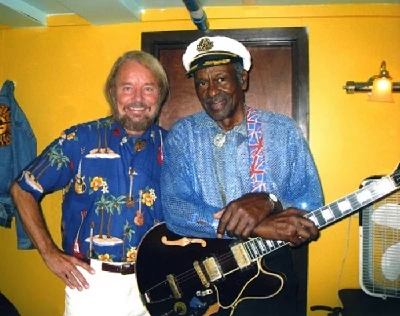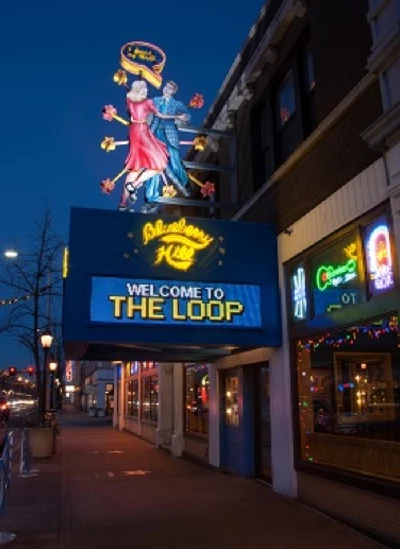published: 3 /
10 /
2013

Lisa Torem talks to St Louis club owner Joe Edwards who has now put on at his club Blueberry Hill nearly two hundred shows with the legendary Chuck Berry
Article
“The 200th time will be this January 2014. Tomorrow is the 196th…although he has played here a couple of other times, unannounced, before that. So that’s the official count,” confirmed the friendly owner of Blueberry Hill, about Chuck Berry’s local appearances.
Joe Edwards has owned, since the early 1970s, this fashionable St. Louis nightclub on the Delmar Loop strip that hosts not only contemporary big name acts but once-a-month performances by rock and roll icon and good friend, Chuck Berry. This very strip was once run down and downright dangerous before Edwards took a chance on turning it around. His Moonrise Hotel has a space theme – another good reason to collect facts and memorabilia that by inspiring conversation bring strangers together. Edwards has revitalised this strip and it is a cultural paradise. Steps away, gold stars in the pavement feature names of St. Louis Walk of Famers, like Ike and Tina Turner. And a stunning bronze statue of Berry invites tourists to capture the moment in a flash.
But Tuesday morning, when I first spoke to Joe by phone, I hadn’t yet seen his all-purpose venue, which includes a spacious dart room, Elvis Room and Pac Man room. Getting to St. Louis by car from Chicago meant taking in little snippets of the famed Route 66; an antiquated Philips 66 sign; a one-person manned frozen custard stand, which included a window that snapped shut like the chilling kind that graced an Al Capone speakeasy; an all-purpose truck stop featuring everything from snow globes to greasy fried chicken and, of course, hoards of glistening cornstalks.
In contrast, Blueberry Hill stokes the senses like a deep-dish slice of Las Vegas. From the neon statues of youthful teens; vintage and historically rich jukeboxes to the incredibly detailed display cases; the flamboyant eye candy draws you into this exciting establishment, like a magnet to filings. Edwards, however, despite his business savvy, does not resemble a typical businessman. His signature outfit consists of a Hawaiian shirt and shorts. His hair is pulled back in a ponytail. He can also be found smiling and standing next to hundreds of politicians, movie stars and rock stars on framed photos that decorate the walls: Obama and Edwards, Slash and Edwards, actor John Goodman and Edwards…and dozens of times with old friend Berry.
PB: How do you feel Chuck’s performances have changed since he first started appearing at Blueberry Hill?
JE: He’s getting on in years, and all, so sometimes he’ll forget a lyric here and there a little more than before, but with his daughter (Ingrid Berry Clay) performing with him, who is a sensational vocalist and harmonica player and his son, Charles Berry Jr., also playing guitar, it’s pretty exciting. It’s a great family affair – plus just a crackerjack band behind him. Jim Marsala, his bass player for forty years, and Keith Robinson, who is a real strong drummer and Bob Lohr is just a phenomenal keyboard player, as close to Johnnie Johnson as anyone in St. Louis. They’re always good. They have never ever put on a bad concert. Some are great and some are really, really good -- the audience is so excited to see him. They come from all over the world. They’ll plan trips from Japan, the Netherlands or Brazil. And there are a lot from St. Louis people and from other states.
It’s a small room. The capacity is 340, which really makes it an intimate affair. One thing I’ve noticed about Chuck is his love for connecting with an audience is never diminished, and that’s why he still performs. He doesn’t need any money. He’s always been wise that way, but he really does love performing. I always love that magic moment where he starts playing and the band starts playing – sometimes it can happen during the first song, sometimes it takes two or three songs – but all of a sudden they click and they’re just locked in, and then it might take half a song and it might be right away or it might take three more songs until he and the audience just click along with the band, and then it’s just off to the races. It’s just so exciting.
PB: What’s the number that gets everybody up dancing?
JE: He has so many anthems. It’s amazing. It could be ‘Maybelline’. It was his first song that charted – the song that broke through the country charts of R & B and the pop charts. ‘Johnny B. Goode’ always gets a rise out of people because that’s usually the song where he’ll do the duck walk. It’s always unpredictable. He never knows what he’s going to play until about three tenth of a second before he starts it.
But there are plenty of other ones: ‘Roll Over Beethoven’ and ‘Rock and Roll Music’ and ‘School Days’ which has the lyric: ‘Hail, hail, rock and roll.’ It’s amazing to have one anthem for a songwriter or a singer but multiple ones… I mean, there are only a handful of others like that, like the Beatles, the Stones and Chuck Berry. There are very few that have anthems that everybody recognizes and goes nuts after…
PB: Do you usually get an older crowd?
JE: No, it’s a real mixed age group. There are a lot of older fans, but there are a ton of people in their twenties that want to see the first person inducted into the Rock and Roll Hall of Fame. They’ve heard so much about him, and there’s a beautiful eight foot high statue across the street from Blueberry Hill, and his St. Louis Walk of Fame star and plaque are right in front of the door, and there’s something kind of magical. And there is more Chuck Berry memorabilia inside Blueberry Hill than any place – old posters from the Fillmore West where he headlined over the Grateful Dead, Janis Joplin and Chicago. People love seeing all of those items plus his Kennedy Center Award and a lot of items from the 1987 ‘Hail Hail Rock and Roll’ movie.
PB: Were you with Chuck Berry when the city unveiled the statue?
JE: There were several speakers, but I was the one present just before he accepted it.
PB: He’s dressed in casual attire, wearing his sailor cap…
JE: The statue was like a young Chuck Berry. He kind of wanted it from those days so the sculptor, Harry Weber, did a wonderful job of studying early photographs. Harry is known for his in-motion statue knowledge. He had Doug Flutie, in Boston, and other people, in motion, like hockey players, and this one is just wonderful because the whole statue rests on the ball of one of his feet, so it’s almost touching the ground and he’s just about to go into the duck walk and he has a tuxedo on in the statue and a full head of hair blowing. It’s pretty great.
PB: What is unique about the Duck Room, where Chuck performs?
JE: Everything in it is duck related. There are figurines of Daffy Duck, Daisy and Donald Duck, all sorts of duck decoys: classic and collectable ones. There are rubber ducks and a lot of comic books. Then there’s a whole collection of underground comics that involved ducks from the 1960s and 70s, and then Howard the Duck, who was conceived and written by a St. Louisianan, Steve Gerber, right in our area. Every issue is framed and in the Duck Room. It’s kind of fun and whimsical like a lot of things in the Delmar Loop.
PB: The first thing that caught my eye was the jukebox. The first collection you had included hundreds of standards.
JE: We’ve finally gone to a jukebox that is capable of having over 200,000 selections now just because, by rotating all of the 45s, you get the selection now that other places are starting to get. The look is that curved-top Wurlitzer look, but it’s a wonderful high-tech selection where people can find just about any song they want to play.
PB: How does the younger generation relate to the jukebox?
JE: They like it a lot. It’s played probably more than any jukebox in St. Louis – just because we’ve always been known for it. It’s the same thing with the photo booth. I think they really like “retro” – at least in their minds – items. People can take all the pictures they want with their iPhones, but there’s still something pretty magical about the photo booth. They’ll go in there and start kissing or hamming it up, and it is the same with the jukebox. They really love just playing the songs that they want. It’s not a rite of passage exactly, but it’s kind of a fun thing.
PB: So, if some patrons come in to hear Chuck and they’ve got some change and time to hear some selections, what do you recommend?
JE: On a Chuck Berry night, they’ll play some Chuck songs, of course, but they’ll also play some of the earlier rock stars like Jerry Lee Lewis, Little Richard, Fats Domino, Buddy Holly and the Everly Brothers, but they’ll play a little of everything. They’ll play other versions; covers that other people did…The Rolling Stones’ first release was a single called ‘Come On’, which was a Chuck Berry song and, of course, the Beatles had a big hit with ‘Roll Over Beethoven’ and ‘Rock and Roll Music’, so they’ll do that just for fun to compare them.
The ones that are alive today that had hits in the mid to late 1950s, they were all piano players. Chuck’s the one who made the guitar a star. Jerry Lee Lewis, piano player, Fats Domino, piano player, Little Richard, piano player, Chuck Berry, guitar player – over his head, behind his back.
He not only was a great singer and songwriter but he was a great choreographer. He just, intuitively choreographed his first great rock and roll shows, including coming up with the duck walk, which is still mimicked by young bands today. It’s one of those moves that people just do if they’re a guitar player and playing a rocking song.
PB: Are there people you would still like to see play at Blueberry Hill? I know the Pageant, your other venue, books acts, too.
JE: The Pageant has lots of other big name people also, and it’s a bigger place -- over 2000 capacity. Bob Dylan has played there, Foo Fighters, Mumford and Sons, Dolly Parton, Willie Nelson. It’s so great to see people of all musical genres play there. They really like it. It’s a good venue also.
PB: Since opening Blueberry Hill in the early 70s, you have created graffiti T-shirts, featured a full menu, and built several “retro” bowling allies, revamped the Tivoli Theater and run a boutique hotel, a few doors down.
JE: I work long hours. I really enjoy it – to create a whole neighborhood, where it is exciting, quirky…so many one-of-a-kind stores. There’s the Moonrise Hotel -- I always like to have a lot of display cases. Of course, it’s more lunar-related and astronaut-related.
At the Tivoli it is movie related. At the PinUp bowl, it is a combination of bowling artifacts and pin up artifacts, and at Blueberry Hill it’s all sorts of pop culture. There are several different rooms, with dozens and dozens of display cases of various things from Michael Jackson to ‘Mad Men’ to ‘The Simpsons’ to sheet music from a hundred years ago.
PB: Do you have a crew that helps you obtain this memorabilia?
JE: No, it’s all stuff I’ve done myself and I put them all in the display case too. Then I don’t have to be frustrated and say, “Why don’t you put this one over here? This one should face in, not out.” And I don’t know if I’m right or wrong, I just like doing it. I’ve just been a collector my entire life, from a little kid on. I had understanding parents that didn’t throw stuff out, which was nice.
PB: What’s the most popular display case?
JE: The first one that people see is the Howdy Doody. It’s the largest publicly displayed collection in the country. The Chuck Berry display cases are really popular. The Simpsons, everybody of every age relates to, and there are two different display cases of them. Everyone has their own favourites. In the dining room, there are these porcelain Beatles dolls. It’s not just putting ‘Sgt. Pepper’ clothes on. They actually sculpted each face differently, like they really were. Those are pretty rare and colourful too, and lunch boxes and several Wurlitzer jukeboxes on display and a Seeburg. It’s kind of fun for people to see everything.
PB: When I visited Memphis, tourists had access to a trolley system, which took them to all the key attractions. Will this happen soon in St. Louis?
JE: The trolley is still awaiting final approval from the Federal Transit Administration to go forward with the grant, which we hope to get this November or December.
The idea is to make it easy and fun for tourists and to attract economic development due to the fixed track nature of the project. It’s been proven in other cities, too, that once you have the fixed track in, then people will invest in new buildings or renovating old buildings because they know the tracks can’t move. You can’t, out of the blue, change the route, and this way it will connect the Loop to the twelve million visitors to Forest Park attractions.
Forest Park is bigger than Central Park and it has these wonderful attractions: the art museum, zoo, science centre, the municipal opera, and almost everything is free, which is just amazing. It’s supported by an art tax. That’s going to be great for St. Louis, and it will be a prototype of how to expand other neighborhoods and to connect them to each other and to our Metro link, and help St. Louis get better and better.
PB: What’s unique about Blueberry Hill and how does it compare to other clubs in the Midwest region?
JE: I took out a bearing brick wall in the basement. I wanted a really good stage and high heights, like ten-foot ceilings – seven-foot ceilings were there. I actually lowered the floor of the basement four feet and then repoured it. It took about six months manually. I had guys carrying out buckets. Then I put a new foundation in that section of the building, while it was supported by temporary columns.
Bands have told me that it’s probably the best club space this size of any place they’ve played. It’s intimate, wider rather than deeper – so you’re really close to the band and they’re closer to you. The sound is top notch. In fact, I just completed another upgrade, the finest speakers made today and a brand new LED lighting system, so they’re not as hot on the stage and yet you get a nice wash of colour when you want it so I’m always trying to improve. I always invest back into the place. I think bands really, really appreciate that.
And for a club this size to have a stage as big as it is and to have a dressing room with a shower is very rare, and the fact that they can come in through the back; they don’t have to go through the crowd to go up onstage to start the show. They can actually make that big entrance. A lot of people have played there - Alanis Morrisette, Grandmaster Flash, Duran Duran, Jewel – a lot of acts that were too big to play at Blueberry Hill. Maybe they would play a 20,000 seat place in the evening, and then they would do a special radio broadcast, playing four songs that afternoon, and they always picked Blueberry Hill because we have really good sound and lights and security and our staff knows what they’re doing, and so we’ve been really fortunate to get all sorts of exciting people that normally would be at the Pageant or bigger.
PB: What about one of those piano players you mentioned earlier, Jerry Lee Lewis? Has he played the room?
JE: He’s not played Blueberry Hill before, but it would be marvellous some year if he did. It would be fun to have him come in and surprise Chuck one night.
PB: Final question. What is important to tell Chuck Berry after all these years?
JE: Well, he came over to my house last night and we talked for about two hours, reminiscing about things. For me, it’s just sheer magic to see him play a stage the size of the ones he played when he first started out and really connect with each member of that crowd. It’s so great watching the expressions on people’s faces in the audience from the side of the stage and just seeing the joy that his music brings them. And for them to be able to see him after they’ve heard his music for years and years or new people that are just discovering it is just magic. I don’t know a better word to describe it.
PB: Thank you.
Picture Gallery:-

